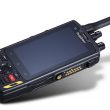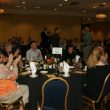Is your two-way radio system balanced?
The base station noise floor, vehicle noise and ambient noise in the service area can all contribute to throwing a radio system out of balance. Here’s how to fix it.
In a balanced two-way radio system, the talk-out power closely matches the talk-in power. If you are like most radio users, your system is far from balanced, to the expense of other radio users who share the same site.
Initially, radio had merit for the police departments by notifying the cops via “the radio waves.” Some of you older folks will recall tuning an AM broadcast radio to the high end of the band, near 1.7MHz, to hear police calls. They were usually one-way broadcasts. Police were expected to respond to the calls received. Some time later, in the late 1940s and early 1950s, two-way radios were more readily available for public safety communications. Typically it would be a Motorola or GE VHF lowband or highband base using a pair of Eimac or RCA 4-125 transmitting tubes with 250W to 300W output to a unity-gain ground-plane antenna. The mobile was probably a Motorola 5V with a healthy 15W output power using a roof-mounted unity-gain antenna for 150MHz, or a Master Mobile spring base whip for 30MHz-49MHz. If the budget allowed, one might have had a Motorola 30D or a GE Pre-Progress line. In any case, it was hard to get more than 50W reliably using dynamotors to generate high voltage.
That 300W base station and 15W mobile setup had a power level ratio of 20:1. Today, you will probably find the base station at 100W, and now we must talk to the portables at 5W – again, a ratio of 20:1. Essentially, we are where we were 50 years ago. What have we gained?
An exception to this example was the combination of a 100W mobile and a 100W base station. Even in that case, are you still balanced? Let’s look at a few concepts that have often gone unnoticed.
What is the base station noise floor? What is the vehicle’s internal generated noise? What is the ambient noise of the service area you must cover? They can all upset the balance.
At the base station The site noise floor is easily measured and should be in the records of the station. This procedure, covered in Motorola, GE and RCA tech manuals in years past may be unfamiliar to new technicians. The most simple test appliance for the procedure is an isolated connection to the coax cable – one that will not disturb the normal operation of the transmission line. This isotee is fabricated by eliminating the direct connection of one of the points of a coaxial tee connector. Removing this connection as shown in the diagram at the left allows some signal to enter the cable without double-terminating the cable. (When you make an isotee, it is suggested that it be painted so it won’t be confused with an unmodified one.) The diagram on page PS4 shows the connection of a signal generator to the base station with an isotee for noise floor measurement. A directional coupler is a good device for this application and is preferred. However, the isotee is inexpensive and can be fabricated on site if the directional coupler is left in the shop.
Connect the isotee to the receiver input, and connect the other end with the appropriate termination, usually 50V. The isolated port is connected to the signal source. Then adjust the signal generator to some reference point, usually 20dB quieting or 12dB SINAD for the analog world. Note the output level of the signal generator in decibels above one milliwatt. Remove the termination and connect the base station antenna to this port. Adjust the signal generator to a level that gives the same previous reference point, 20dB or 12dB sinad. The difference between the two signal generator levels is the site noise. If you don’t see any change, you are fortunate. If the readings are from 6dB to 30dB, you are not alone – your station is somewhat “deaf.” A good practice is to take these measurements at least every six months and keep a log on site. It will answer lots of questions later when your coverage seems to have evaporated for no apparent reason.
There are various sources of noise, including: remote network terminals, (i.e. trunking computers), synthesized equipment (see below); battery chargers that use silicon-controlled rectifiers for voltage regulation; switching power supplies; commercial cell/PCS transmitters, adjacent channels; T-1 modems connected to the cell/PCS station; tower strobe light equipment; and most often, FM and TV transmitters running high power.
The mobile One major and often overlooked item is the antenna placement on the vehicle. The optimum location on a car is the roof. However, as seen in the photo on page PS6, other appliances installed nearby not only affect the antenna’s performance but often are the source of noise when operating. The antennas mounted as shown on page PS8 not only have higher VSWR, their radiation is limited to the direction having the most metal. Any of these installations should be checked for desense.
To measure desense of a vehicle, do not use the isotee method. Extra cabling for instrumentation will cause errors. Park the vehicle in a clear spot, engine off, with only the radio on. Place a signal generator about 50 to 100 feet away, on-frequency with the correct deviation and connected to a short antenna. (The antenna that came with the generator will do.) Apply enough signal to establish a reference point, such as where the squelch opens, and note the RF signal generated. Now start the engine, turn on all appliances, light bar, air conditioner, fans and anything else that is normally used. Note the increased signal generator level required to achieve the same reference point. If the signal generator’s output was increased to 2.5dB or 3.5dB, you’re not alone. This additional noise is often overlooked. Any desense greater than 3dB, however, should be corrected.
The surroundings Some of the problems with ambient noise at the receiver’s location arise when the area itself is extremely noisy. Faulty neon signs, concentration of computers, digital telephones, ignition noise of a nearby vehicle and (in the case of portables), noise generated by the user’s clothing can cause extra noise. Although these noise sources are always present, the portable/mobile is usually not near any one of them for a long period of time. In any case, ambient noise limits reception. If this affects the only location in which you need coverage, then the system does need to be balanced in your favor.
Instrumentation Attempting to use a digital spectrum analyzer to find noise and/or noise floor is a “no-win” situation. Noise is generally ignored by digital processing, which is one of its strong points. One case involved a PCS operation interfering with a lowband base station. The PCS engineers set up a digital spectrum analyzer and found no noise. They ultimately had to rely on the lowband base station’s receiver as their troubleshooting monitor. The problem was eventually fixed, but their expensive digital spectrum analyzer showed no change. Noise investigation needs to be conducted in the AM mode if possible.
Synthesizers Frequency synthesizers for frequency control are used in signal generators, receivers and transmitters. Although they offer frequency agility, they also generate noise. For example, a current-model mobile transceiver was undergoing an intermodulation test to see if it performed within published specifications. The test was conducted using several Cushman service monitors as signal sources, and the receiver failed the test. The receiver did pass the test when older Measurements Corp. signal generators were used. These old devices have oscillators that generate RF on-frequency, have little harmonic content and have virtually no noise. The Cushman service monitors are synthesized sources that not only generate the “on-frequency” signal but have spurs close to the desired signal. (For the curious, check the Cushman with an analog spectrum analyzer.)
For transmitters, synthesizers seem to be the industry standard today. However, they also generate noise as a byproduct of operation. Case in point, one of the major brands of base stations was recently installed, replacing an older crystal-controlled radio. Two mountaintop base stations on adjacent channels just 30 miles away immediately experienced noise from this new product. The reason: This product is nothing more than a high-power, synthesized signal source with no tuned circuits anywhere in the transmitter line-up. The only tuned circuits used in this product are in the receiver. This manufacturer has chosen a fast AFC loop for the radio to “come up” on-frequency quickly. Other radios on the market have a slower AFC response time, which reduces the amount of sideband noise.
Some of the cellular and PCS telephones operate in the milliwatt range, but the cell site transmitters are in the hundreds of watts – not a balanced situation, for sure. The real problem here is that when all the cell site transmitters are on the air, they can radiate near the kilowatt power level. It is impossible to receive anything if one needs reception nearby. Many 800MHz public safety systems appear to go deaf when a cell system is activated nearby – a classic case of an unbalanced system where there is more transmitter power than necessary. The Amateur Radio Rules and Regulations clearly instruct operators “to use no more power than absolutely necessary.” Perhaps that concept should be implemented in the commercial world also.
Most two-way radio coverage problems are due to the high level of site noise at the base station site, often caused by high power levels, like those used by paging transmitters or many accrued transmitters. Also, the performance of a receiver is hurt when subjected to synthesized RF sources. The newer products create more noise than the older products they’re replacing. The real question is why these base stations are being forced on the user when the base station’s life will probably be at a fixed location and only on one frequency.
Why is high power tolerated when the site noise prevents reception for portables and low-power radios? Isn’t it time we reduced the transmitter power to something like 25W-35W? Why are all of the users on a common site forced to have additional noise as neighbors? To build a transmitter that is “one size fits all” might be a good sales strategy, but the increased noise limits the number of radios that can exist on a site.
If the industry is having problems now with wideband, how can it meet the 12.5kHz and 6.25kHz spacing if the synthesized noise problem is not corrected?
It is time we asked the radio manufacturers to keep the transmitter noise at least equal to the older crystal radios. Just because we can adjust the transmitter to maximum output of 125W-150W, is it necessary to do so? We should attempt to balance the RF environment now.












